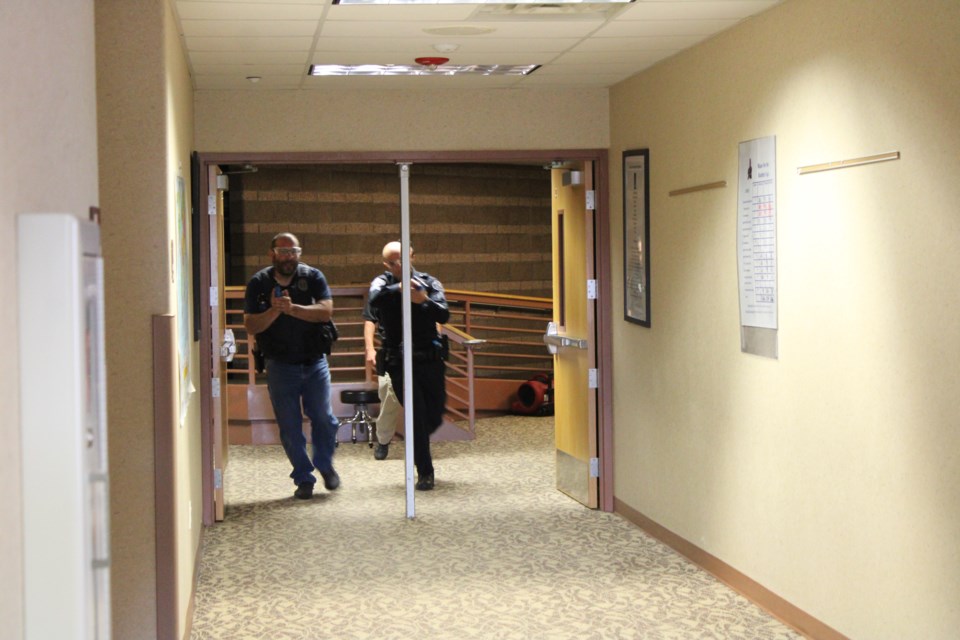Guns drawn, officers stride in formation toward a classroom at Altona Middle School after hearing gunfire and reports that an armed individual had taken someone hostage.
The two officers stop just outside the doorway to quickly scan the looming danger and run inside. One officer shoots the assailant several times while another quickly tends to someone lying face down on the floor. He assesses the victim’s condition and radios for backup and medical help.
The shooter is actually a paper poster that shows where the fake bullets landed. The victim is an officer wearing a protective helmet.
While the whole scenario takes less than five minutes to transpire, it mirrors what police could likely face should they be called to the scene of a real-life active shooter that has taken over a classroom, Longmont Police Sgt. John Garcia said Friday.
The exercise was part of a two-week stretch of classes and on-the-ground training for some of the area’s police officers to prepare them for an unthinkable attack on a school.
Officers study a specific curriculum during the “Active Killing Response” course, Garcia said.
“We train to stop someone who wants to do harm and kill innocents,” the 13-year veteran with Longmont Police and who oversees the department’s School Resource Officers.
“The mission is for us to stop the killing and stop the dying,” Garcia said.
Garcia is also a 10-year-member of the Longmont SWAT team, which helped supervise the training. All certified members of the local police departments take the course, which consists of two classes a day with 20 officers per session, he said.
Officers/students tackle a variety of staged situations during the two-week training including doing sweeps of a school as members of three-or-two member teams. They also drill as a one-member team, working to control their emotions as they search hallways for a shooter.
“We want them to be able to assess the situation and slow things down mentally, to get a sure handle on the situation in their mind,” Garcia said.
Longmont’s training came while under the shadow of the response to the school shooting in Uvalde, Texas which left 19 students and two teachers dead. It was the worst school shooting in Texas history.
Parents and law enforcement have largely vilified the police response to the lone gunman who shot students and teachers inside the school before he was finally confronted.
Officers at Friday’s training at Altona declined to comment about the specifics of the Uvalde response.
“I don’t know what training they had to handle the response,” Garcia said. “Obviously things did not go well.”
Garcia did say that one of the sessions in Longmont covered the steps in deciding who was best to take over authority in the response to a school shooting.
“Early on someone has to step up and take charge,” Garcia said, especially as a second wave of officers prepare to enter a school, grocery store or office building.
“You have to have someone or a group of officers make sense of a problem and go from there,” Garcia said.
Sgt. Ian Albert, a 19-year veteran of the Frederick Police Department, said his first thought in watching the Uvalde response was “tragic.”
He hopes the training in Longmont will help him better prepare for the chaos offered by a Uvalde-type school shooting, Albert said. “We have had situations before where a suspect has barricaded themselves but nothing like this where it’s so quick and fast,” he said.
“The training here is invaluable,” Albert said. “Unfortunately, departments have to be ready for something like this. The shooting in Uvalde was tragic. The best thing we can do is figure out what we can learn from something like that.”



